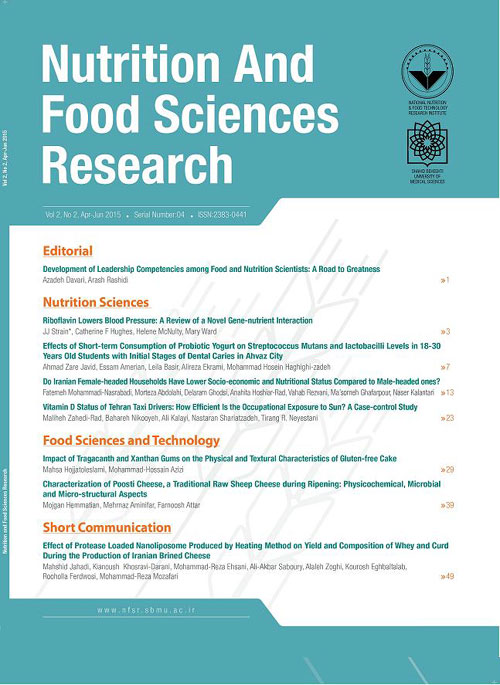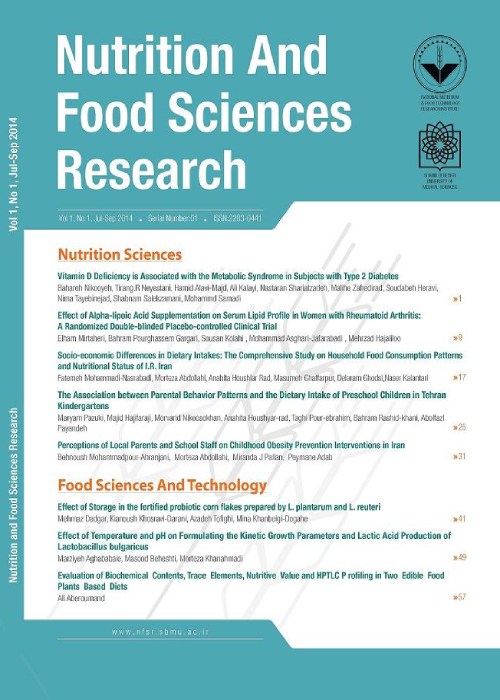فهرست مطالب

Nutrition & Food Technology Research
Volume:2 Issue: 2, Apr-Jun 2015
- تاریخ انتشار: 1394/02/03
- تعداد عناوین: 8
-
-
Pages 3-6Hypertension, defined as a systolic/diastolic blood pressure of 140/90 mmHg or greater, is estimated to carry a three-fold increased risk of developing cardiovascular diseases (CVDs). Evidence from genome-wide association studies has identified an association between blood pressure and the gene encoding the folate-metabolising enzyme, methylenetetrahydrofolate reductase (MTHFR). Recent meta-analyses of observational studies show an increased risk of hypertension in people homozygous for the 677C→T polymorphism in MTHFR. Riboflavin in the form of flavin adenine dinucleotide (FAD) acts as a cofactor for MTHFR, and the variant enzyme is known from molecular studies to become inactive for having an increased propensity to dissociate from FAD. Our findings revealed that CVD patients with MTHFR 677TT genotype (compared to CC or CT genotype) have significantly higher blood pressure, and that blood pressure was highly responsive to intervention with riboflavin, resulting in significant lowering, specifically in the TT genotype group. Further investigations confirmed this gene-nutrient interaction in hypertensive patients (with and without overt CVD), and showed that the blood pressure lowering effect of riboflavin in the TT genotype group was independent of antihypertensive drug use. Although the precise mechanism linking this polymorphism to hypertension remains to be established, it would appear that the biological perturbation, which leads to higher blood pressure in individuals with MTHFR 677TT genotype, is modifiable by correcting the variant MTHFR enzyme through enhancing riboflavin status. Thus riboflavin, targeted specifically at this genetically at-risk group, may offer a personalised non-drug approach to managing hypertension.Keywords: Blood pressure, Hypertension, MTHFR, Personalised medicine, Riboflavin
-
Pages 7-12Background And ObjectivesDental caries, caused by oral microbial flora, is considered as one of the most common infectious diseases in human. The aim of this study was to determine the effect of short-term consumption of probiotic yogurt containing bifidobacterium lactis on salivary streptococcus mutans and lactobacilli in students with initial stages of dental caries.Materials And Methods66 students (18-30 years old) with initial stages of dental caries were selected in this single blind randomized clinical trial. The subjects were randomly assigned into two groups: intervention group received 300g/d probiotic yogurt, and control group received 300 g/d conventional yogurt for 2 weeks. Un-stimulated fasting saliva sample was collected pre- and post-intervention. Bacterial counting was performed for salivary streptococcus mutans and lactobacilli. Salivarius Mitis agar and Rogosa agar were used as culture media for streptococcus mutans and lactobacilli, respectively.ResultsThe number of streptococcus mutans in saliva was significantly reduced in the intervention group post-intervention (P>0.001); however, it was not changed in the control group (P=0.71). Streptococcus mutans was also significantly lower in the intervention group compared with the control group post-intervention (P>0.001). Although salivary lactobacilli was reduced significantly in both groups post-intervention (P>0.001), this reduction was not significantly greater in the intervention group compared with the control group (P=0.594).ConclusionsIt is suggested that consumption of probiotic yogurt may be useful to prevent the progression of dental caries.Keywords: Probiotic yogurt, Streptococcus mutans, Lactobacilli, Bifidobacterium lactis, Tooth decay
-
Pages 13-22Background And ObjectivesPoverty and risk of nutritional vulnerability of female-headed households (FHHs) are usually higher than male-headed households (MHHs). This study aimed at comparing the socio-economic status, and food and nutrient intake of FHHs and MHHs based on the data from Comprehensive Study on Household Food Consumption Patterns and Nutritional Status of Iran (2001-2003).Materials And MethodsIn this cross-sectional study, the samples were urban and rural households of the country, which were determined by the Statistics Center of Iran using systematic cluster method. The socio-economic and demographic characteristics of households were asked by interview and observational techniques, and recorded in data forms. The dietary data were collected using three consecutive 24-hour recalls completed by nutrition experts. For the purpose of this study, FHHs and MHHs were compared in terms of socio-economic characteristics, consumption pattern and nutritional status.ResultsFrom 7158 households of the study, 5.5% were female-headed including 116 rural (1/6%) and 280 urban (3.9%) households. Educational and occupational status among FHHs were significantly lower than among MHHs (p<0.05); however, in terms of average total expenditure per capita, accommodation type, and lodging facilities such as electricity and water consumption, no significant differences were observed between FHHs and MHHs. In contrast, MHHs enjoyed more facilities. The significant difference in food consumption among the urban households was only found in fruits and sweets, and in the rural areas, in oils and fats group (p<0.05). In FHHs, calcium, Vitamin C and thiamin intake was lower than in male-headed group. In the rural areas, the retinol and energy intake posted a lower and higher level, respectively, over MHHs (p<0.05).ConclusionsIn spite of lower socio-economic level among FHHs, the differences in food and nutrient intake were only seen in fruits, calcium, Vitamin C and retinol intake, especially in the rural areas. Therefore, in the diet of these households, energy dense foods should be partly replaced by foods providing nutrients such as Ca, Vitamin C and retinol.Keywords: Female, headed households, Food consumption patterns, Nutritional status, Family structure, Socio, economic status
-
Pages 23-28Background And ObjectivesDay-shift taxi drivers have a long duration of direct sun exposure. However, the efficiency of this occupational exposure in vitamin D synthesis has not been addressed yet. The aim of this study was to assess the vitamin D status of taxi drivers in Tehran, and examine vitamin D status association with some anthropometric and circulating biomarkers.Materials And MethodsIn a case control study, 53 taxi drivers and 80 apparently healthy subjects from other occupations were enrolled. Questionnaires for demographic data, supplement use, and duration of sun exposure were completed. Weight, height and waist circumference were measured. Blood samples were taken from all participants for complete blood cell count, fasting blood glucose (FBG), lipid profile, and 25-hydroxycholecalciferol (25 (OH)D) measurements.ResultsTaxi drivers, as compared to the controls, had significantly higher body mass index (BMI), waist circumference (WC), serum triglycerides (TG), and 25(OH)D concentrations. Moreover, 56.6% of the drivers had more than 2 hours of sun exposure during a day.ConclusionsDespite having higher circulating concentrations of 25(OH)D, the taxi drivers had higher cardiometabolic risk factors. These findings indicate a need for nutritional education for taxi drivers.Keywords: Vitamin D, Driving, Sun exposure
-
Pages 29-37Background And ObjectivesThe quality of cakes made of wheat flour depends on the quantity and quality of its gluten proteins; however, these proteins may have side effects for some people, including the patients with celiac, and the only way to cure this disease is to take a lifelong gluten-free diet.Materials And MethodsThis research aims to produce gluten- free cake by using rice flour and xanthan and tragacanth gums, including two treatments of xanthan gum (0.5 &1 %), two treatments of tragacanth gum (0.5 & 1%), four combination treatments of xanthan gum and tragacanth, and one control treatment (without gum). The effects of tragacanth and xanthan gums on the texture characteristics, moisture content, water activity (aw), color, volume, apparent density, and porosity of the resulting cake were investigated. The data obtained were analyzed by the use of factorial experiments with three replications (3*3) and a Completely Randomized Design (CRD).ResultsThe results showed that the treatments containing gum have less texture stiffness compared to the control. Among the treatments, those having the combination of 0.5% tragacanth and 1% xanthan gum hold the maximum content of moisture. The L component amount of gluten-free cake samples was increased compared to the control while the rate of a and b components was decreased. The maximum amount of aw is related to the 0.5% treatment tragacanth and 1% xanthan, and the lowest aw belongs to the control. Apparent and bulk density has a difference with the control, and the minimum amount and the maximum amount belong to the treatment containing 1% tragacanth and the control, respectively.ConclusionsSamples containing 1% xanthan and 0.5% tragacanth could be desirable due to less texture stiffness, maximum content of moisture and aw, high color score, minimum density, and better keeping quality during the storage period.Keywords: Gluten, free cake, Tragacanth, Xanthan, Cake texture, Celiac
-
Pages 39-48Background And ObjectivesThis study is the first research on the physiochemical characteristics, microbial population and microstructure of Poosti cheese over 90-days of ripening. The main difference between Poosti cheese and other types of traditional cheese is the skin, which is used for its storage.Materials And MethodsPhysicochemical characteristics including moisture, salt, pH, acidity, fat, and rate of water-soluble nitrogen to total nitrogen were measured during the ripening. Total population of mesophilic and psychrotrophic bacteria, Escherichia coli, Coliform, lactic acid bacteria, yeasts and moulds were determined during the aging. Micro-structural properties of Poosti cheese were evaluated by scanning electron microscopy (SEM). Three-dimensional (3D) images, binarised micrographs and surface plot were obtained by analyzing the two-dimensional (2D) SEM micrographs by Image J software.ResultsThe results showed that the moisture content, pH and fat percentage were decreased during the aging; however, salt, acidity, and ratio of water-soluble nitrogen to total nitrogen were increased during this time. Besides, the total count of bacteria was decreased during the aging. Finally, the SEM images indicated that the density of casein network, the number and depth of pores, and also roughness of the structure were increased during the ripening.ConclusionsAccording to this study, physicochemical characteristics of Poosti cheese were changed during the aging (salt and fat were increased, while pH and moisture were decreased) as a result of ripening in the skin and high microbial population of raw milk. The microstructure of Poosti cheese was changed during the ripening due to water and salt movement, and the fermentative activity of microbial population.Keywords: Traditional cheese, Physicochemical properties, Microbial properties
-
Pages 49-53Background And ObjectivesFast proteolysis of cheese in ripening process may lead to the premature attack of casein, release of the majority of enzymes into the whey, and loss of cheese composition from curd to whey. In this study, the effect of liposomal Flavourzyme on proteolysis of Iranian white brined cheese, as well as on the yield and composition of whey and curd was investigated.Materials And MethodsHeating method (without using any toxic, volatile organic solvent or detergent) was used to nanoliposomal encapsulation of Flavourzyme. So, 0.15% and 0.3% (w/v) Flavourzyme-loaded liposome were incorporated to pasteurized cow milk. Iranian brined cheese was produced in triplicate using a complete randomized design. Then total solids were determined by drying them in an Infrared Oven. Water soluble nitrogen/total nitrogen and non-protein nitrogen/total nitrogen was determined by Kjeldahl method.ResultsEncapsulation efficiency of liposomal Flavourzyme was 25%. No significant differences between chemical components of cheese curd (total solid, protein, TCA-soluble nitrogen, water soluble nitrogen) and whey (total solid, protein) were observed between encapsulated cheese and the control. Cheese production yield in experimental cheese was not different from that in the control cheese (P>0.05).ConclusionsThe results suggest that application of liposomal Flavourzyme for acceleration of Iranian white brined cheese inhibits premature attack of casein and the release of the majority of cheese compositions into the whey.Keywords: Flavourzyme, Nanoliposome, Iranian brined cheese, Heating method


